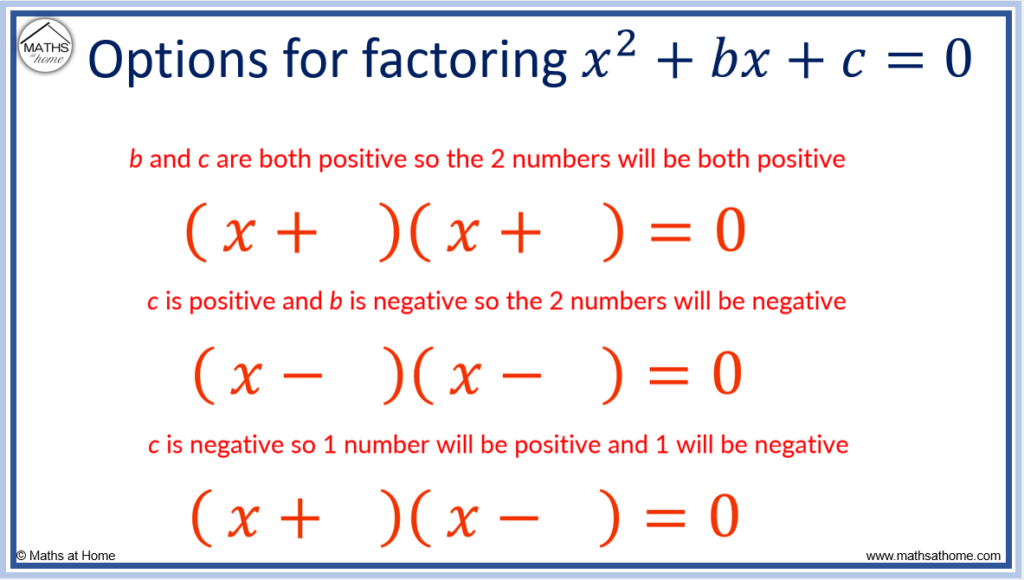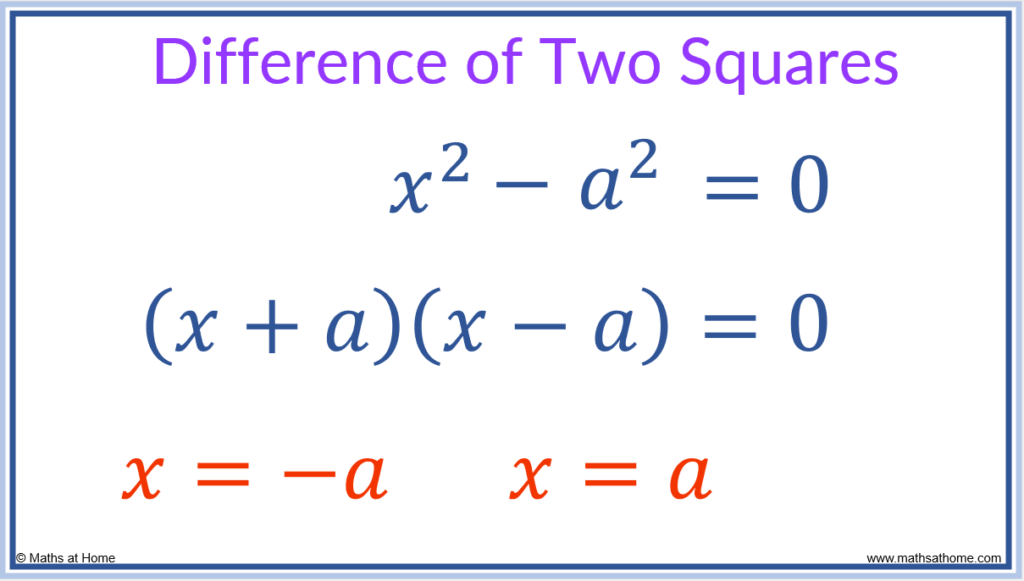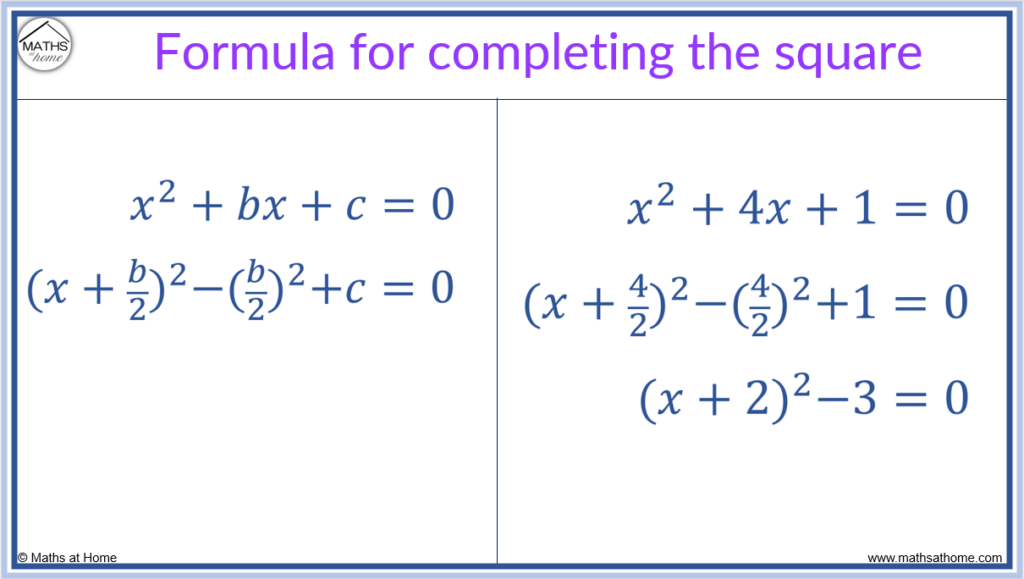Solving Quadratic Equations: Video Lesson
Quadratic Equation Solver
A quadratic equation of the form can be solved using the quadratic formula where:
- ‘a’ is the coefficient of of 𝑥2.
- ‘b’ is the coefficient of 𝑥.
- ‘c’ is the constant term
Enter the values of ‘a’, ‘b’ and ‘c’ into the quadratic equation solver below to calculate the values of 𝑥 that satisfy the equation.
For example, the quadratic equation has ‘a’=2, ‘b’=1 and ‘c’=-3.
How to Solve Quadratic Equations
To solve a quadratic equation, the first step is to set one side of the equation equal to zero. The 3 ways to solve quadratic equations are factoring, completing the square or using the quadratic formula. If a quadratic equation cannot be factorised then completing the square or quadratic formula must be used.
If the quadratic has an 𝑥2 coefficient of 1 then it might be possible to solve it by factorising in the following way:

If the quadratic has an 𝑥2 coefficient greater than 1 or cannot be factorised, the quadratic formula can be used:

Here is a list of the methods that can be used to solve quadratic equations:
- If 𝑥2 equals a number, square root both sides of the equation to solve it.
- If the quadratic only contains 𝑥2 and 𝑥 terms, factorise the 𝑥 out and solve.
- Try to factorise by finding two numbers that add to make the coefficient of 𝑥 and multiply to make the constant term. Solve by setting each factor to equal zero.
- If the quadratic contains an 𝑥2 coefficient greater than 1, try to split the 𝑥 term and factorise by grouping.
- If the quadratic cannot be factorised, complete the square and solve.
- If the quadratic cannot be factorised, use the quadratic formula
.
All quadratic equations can be solved using the quadratic formula so this method will always work for solving quadratic equations.

How to Solve Quadratic Equations using Square Roots
If a quadratic equation is of the form 𝑥2=k, square root both sides. The solutions are 𝑥=±√k. For example, if 𝑥2=4 then 𝑥=±2.
This simple type of quadratic equation can be identified as there is only an 𝑥2 and constant term in the equation.

In this next example, 𝑥2 is equal to a non square number. We still square root both sides of the equation to obtain the solution.
For example, solve 𝑥2-5=0.
The first step is to add 5 to both sides of the equation so that 𝑥2=5.
The next step is to square root both sides of the equation so that 𝑥=±√5.
Evaluating ±√5 on a calculator, 𝑥≈-2.24 or 𝑥≈2.24.

How to Solve Quadratic Equations by Factoring
To solve a quadratic equation ‘𝑥2+b𝑥+c=0′ by factoring:- Think of two numbers that add to make b and multiply to make c.
- Factor the quadratic as (𝑥+m)(𝑥+n)=0, where m and n are the two numbers from step 1.
- Solve the quadratic by setting each bracket equal to zero.
- The solutions are 𝑥=-m and 𝑥=-n.
Solving Quadratic Equations by Factoring: Example 1
For example, solve the quadratic equation by factoring.
Here, and
.
Step 1. Think of two numbers that add to make b and multiply to make c
The numbers 1 and 3 add to make 4 and multiply to make 3.

Step 2. Factor the quadratic as (𝑥+m)(𝑥+n)=0, where m and n are the two numbers from step 1
In step 1, the two numbers that add to make 4 and multiply to make 3 were 1 and 3.
Therefore the quadratic equation can be factorised to
.
Step 3. Solve the quadratic by setting each bracket equal to zero
Either or
.
We find the values of 𝑥 that make each bracket equal zero.
For , the solution is
.
For the solution is
.
Therefore the solutions to this quadratic equation are 𝑥=-3 and 𝑥=-1.
Solving Quadratic Equations by Factoring: Examples with Negatives
To solve a quadratic by factoring, think of two numbers that add to make the coefficient of 𝑥 and multiply to make the constant term.
For a quadratic , use the following rules to find the two numbers:
- If b and c are both positive, the two numbers will both be positive
- If c is positive but b is negative, the two numbers will both be negative
- If c is negative, one number will be positive and one number will be negative
It is easier to factorise quadratics if you know what signs to expect in the brackets.

Here are some examples of solving quadratic equations by factoring.

- In example 1,
.
Since b and c are positive, the quadratic will factor as .
The two numbers that add to make 6 and multiply to make 8 are 4 and 2.
Therefore, the factored quadratic is and so,
and
.
- In example 2,
.
Here, c is positive and b is negative so the quadratic will factor as .
The two numbers that add to make -5 and multiply to make 6 are -3 and -2.
Therefore the factored quadratic is and so,
and
.
- In example 3,
.
Here c is negative so the quadratic will factor as .
The two numbers that add to make 2 and multiply to make -3 are 3 and -1.
Therefore the factored quadratic is and so,
or
.
- In example 4,
.
Here c is negative so the quadratic will factor as .
The two numbers that add to make -3 and multiply to make -10 are 2 and -5.
Therefore the factored quadratic is and so,
and
.
How to Solve Quadratic Equations with Difference of Two Squares
Any quadratic equation of the form 𝑥2-a2=0 can be factored as (𝑥+a)(𝑥-a)=0 using the difference of two squares. Therefore the solutions are 𝑥=a and 𝑥=-a. For example, 𝑥2-25=0 factors as (𝑥+5)(𝑥-5)=0 and has solutions of 𝑥=5 and 𝑥=-5.

Quadratic equations of the form can be solved using the difference of two squares method.
To identify the difference of two squares, the quadratic should be made up of two terms separated by a minus sign.
For the quadratic , this is the same as
.
Therefore this can be factored as and setting each bracket equal to zero to solve,
and
.

The difference of two squares can also be used to solve quadratics of the form . These quadratics will factor in the form
which can be solved by setting each bracket equal to zero.
For example, solve using the difference of two squares.
This can be factorised as .
The solutions are therefore and
.

How to Solve Quadratic Equations with a Coefficient of 𝑥2 Greater than 1
To solve a quadratic equation with a leading coefficient greater than 1, use the quadratic formula or factorise and solve.
To factor a quadratic a𝑥2+b𝑥+c when a is greater than 1:
- Split the middle term into two terms that multiply to make the value of a×c.
- Factor the first two terms and the last two terms separately.
- Factor the whole expression by grouping.
For example, factor and solve the quadratic .
In this quadratic, ,
and
Step 1. Split the middle term into two terms that multiply to make the value of a×c
The middle term of is
. This will be split into two terms that when multiplied, equal the value of 2×6.
is split into
because 4×3=12, which is the same as 2×6.

Step 2. Factor the first two terms and the last two terms separately
The quadratic is currently written as .
The first two terms can be factorised as
and the last two terms
can be factorised as
.
Therefore can be written as
.

Step 3. Factor the whole expression by grouping
In the equation , there is a factor in common which is
.
can be grouped to get
.

Step 4. Solve the quadratic by setting each bracket equal to zero
The quadratic is currently written as .
Therefore either or
.
Solving these equations, or
.

Examples of Solving Quadratic Equations with a>1 by Factoring
Here are some examples of solving quadratic equations with a leading coefficient greater than 1 using the factorising by grouping method.
| Equation | Split the middle term | Factor | Group | Solutions |
How to Solve Quadratic Equations by Completing the Square
All quadratic equations can be solved by completing the square and then rearranging the equation for 𝑥. For example, the equation 𝑥2+4𝑥+1=0 can be written as (𝑥+2)2-3=0. Adding 3 to both sides of the equation, (𝑥+2)2=3. Taking the square root, 𝑥+2=±√3 and so, 𝑥=-2±√3.
To solve an equation by completing the square, follow these steps:
- Complete the square, writing 𝑥2+b𝑥+c=0 in the form
- Move the constant term to the other side of the equals sign
- Square root both sides
- Solve for 𝑥
For example, complete the square and solve, .
Step 1. Complete the square
To complete the square, write in the form
.
In ,
and
.
Therefore completing the square using the above formula, becomes
.
This simplifies to .

Completing the square has now been completed and now we solve the equation by rearranging for 𝑥.
Step 2. Move the constant term to the other side of the equals sign
We add 3 to both sides of the equation so that becomes
Step 3. Square root both sides
Taking the square root of both sides, becomes
.
Remember, when taking the square root, there are two solutions. A positive and a negative solution.
Step 4. Solve for 𝑥
Simply subtract two from both sides so that becomes
.
The two solutions are and
.

Example of Solving a Quadratic Equation with a Leading Coefficient Greater than 1 using Completing the Square
If a quadratic equation has a leading coefficient greater than 1, first factor this coefficient out before completing the square.
For example, solve by completing the square.
Since the leading coefficient is 2, factor this out to get .
We can now divide both sides by 2 to get .
Now completing the square we get .
Solving for 𝑥, we get .
Examples of Solving Quadratic Equations by Completing the Square
Here are some examples of solving quadratic equations by completing the square
| Quadratic Equation | Complete the Square | Solutions |
How to Solve Quadratic Equations with the Quadratic Formula
To solve a quadratic equation a𝑥2+b𝑥+c=0, use the quadratic formula 𝑥=[-b±√(b2-4ac)]/2a.
The quadratic formula is the most reliable method for solving a quadratic equation. It can always be used to obtain solutions.
The quadratic formula
To use the quadratic formula, first find the values of -b, b2-4ac and 2a so that these three values can be entered directly into the formula.
For example, solve the quadratic equation .
Here, ,
and
.
Therefore ,
and
.

Entering these values into the quadratic formula, .
Therefore and
.
and
.
Solving Quadratic Equations with the Quadratic Formula Examples
Here are some examples of using the quadratic formula to solve quadratic equations:
| Equation | a | b | c | Quadratic Formula | Solutions |
| 3 | 5 | 1 | |||
| 2 | 3 | -5 | |||
| 2 | -5 | 1 | |||
| 1 | 3 | -1 | |||
| -1 | 4 | 2 |
Solving Quadratic Equations Not Written in Standard Form
To solve a quadratic equation that is not written in standard form, first rearrange it so that it is in the form a𝑥2+b𝑥+c=0. Then it can be factorised or the quadratic formula can be used to solve it.
Solving a Quadratic Equation Not Written in Standard Form: Example 1
For example, solve the quadratic equation .
The first step is to multiply both sides of the equation by the denominator of .
The equation becomes .
Expanding the brackets, .
Subtracting 4 from both sides, .
can be factorised to give
.
Therefore or
.
Solving a Quadratic Equation Not Written in Standard Form: Example 2
Solve the quadratic equation, .
Expanding the brackets, .
Subtracting from both sides,
.
We can solve this by finding the square root of both sides so that .
Solving a Quadratic Equation when given ‘y’
When given y in a quadratic equation, the corresponding values of x can be found by rearranging the equation equal to zero and solving for x.
For example, in the equation , find the values of
for which
.
Substituting into the equation,
.
Adding 3 to both sides, .
Factorising, .
Therefore, and
.
How to Solve Quadratic Equations by Graphing
For a quadratic equation that is set equal to zero, the solutions are the x-axis intercepts of its graph. Graphing a quadratic is one way to find the x-intercepts. These can be read off from the graph as the solutions to the quadratic equation.
For example, the graph of is shown below.

The graph has x-intercepts of and
.
These are the solutions of .
Solving Quadratic Equations with Complex Solutions
For a quadratic equation of the form a𝑥2+bx+c=0, complex solutions will exist if b2-4ac<0. This is because it is not possible to obtain real answers when finding the square root of a negative number in the quadratic formula. Instead, the solutions will contain imaginary components.
For example, find the solutions to .
a=1, b=2 and c=5.
Therefore, .
Therefore, the quadratic formula, becomes
.
Since ,
.
Therefore simplifies to
and so,
.
